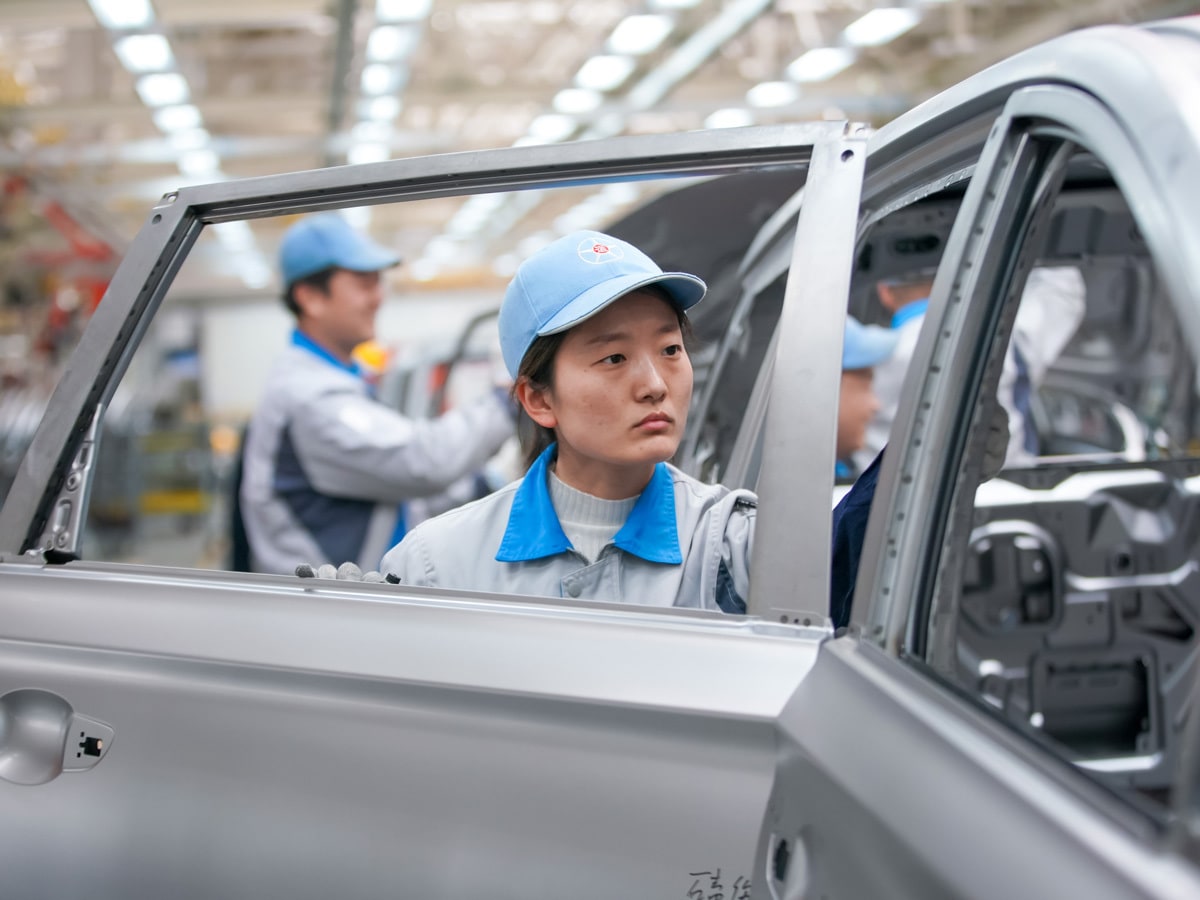Demand for EVs in China rebounded last month, but the road to economic recovery is uneven. Investors need to remain wary about the official data being released by Beijing, according to economist and macro expert Jens Nordvig, while they should also keep in mind there’s a risk of EV makers inflating their sales numbers.
- China extended tax breaks for EV buyers to 2027, which could trigger a wave of new buyers.
- Sales rebounded in June, but investors need to be mindful of the quality of official data.
- How to invest in China’s EV industry: the Singapore-listed Global X China Electric Vehicle and Battery ETF focuses exclusively on Chinese companies in the EV supply chain and is up 12% over the last six months.
With China’s EV industry faltering, Beijing has extended electric vehicle (EV) tax breaks worth around RMB520bn through 2027 in a bid to help sales growth accelerate.
“Even though China has accomplished certain achievements in the new EV industry, the sector still has problems, including insufficient supply of critical technology and uneven development in the wider market,” Xin Guobin, an official from the Ministry of Industry and Information Technology, told Bloomberg.
While Beijing is supporting buyers, it’s no longer propping up manufacturers themselves: subsidies ended on 1 January, triggering an exodus of start-ups from the industry. Today, there are approximately 100 registered domestic EV manufacturers, down from 500 in 2019, while the top four manufacturers have seen their market share rise to 60% in the first quarter (Q1) of this year, up from 44% in the same quarter of 2020, according to Bloomberg.
The EV shakeout has been accelerated by the price cut war triggered by Tesla [TSLA]. The volatile and cut-throat nature of the war forced Nio [NIO] to slash the prices of all of its models by RMB30,000, or 6–9%, in mid-June, as the automaker announced via a post on Chinese social media platform Weibo. It has also ended its free battery-swapping programme.
Back in April, Nio CEO William Li had said the company “will definitely not join the price war” due its low gross profit margin, reported Yicai Global. Blindly cutting prices could do more harm than good in the long run, Li warned.
Domestic players report strong sales for June
Nio’s decision to cut its prices came in the same month that it clocked a 17% year-over year drop in deliveries — down to 10,707 units for the month, from 12,961 one year ago. May’s deliveries were at 6,155, 12.4% down from 7,024 units in May 2022.
Elsewhere, Li Auto [LI] delivered a record 32,575 units last month, up more than 150% from the 13,024 delivered in June last year. Xpeng [XPEV] fell in line with Nio, reporting a 44% drop in its deliveries, to 8,620 units from 15,295 a year ago, However, the automaker’s deliveries were up 14.8% from May, its fifth consecutive month-on-month gain.
Tesla, which doesn’t break down its monthly sales, shifted 466,140 vehicles in Q2, up 83% year-over-year from June 2022’s figure of 254,695.
Momentum and young buyers drive demand
The numbers reported by China’s domestic EV players can be explained in part by a rise in demand for EVs among younger buyers.
“They are increasingly keen on EVs with intelligent features such as autonomous driving systems and AR [augmented reality] technology,” Zhao Zhen, a sales director with Shanghai-based dealer Wan Zhuo Auto, told South China Morning Post last week.
Assumptions that the price war may be coming to an end may have also played their part. Anthony Sassine, senior investment strategist at KraneShares, believes that negative sentiment has been subsiding and momentum is building.
“We should start seeing some momentum building … Especially as consumers in China have been waiting … for a better deal. And now with these subsidies they will be getting that better deal,” Sassine told CNBC’s Street Signs regarding the subsidies last week.
Are you finding this content insightful? Leave us some feedback here.
Weakness in the short-to-medium-term
Despite the optimism, there’s reason for investors to be cautious. Fitch has announced it expects “little impact from the subsidy extension on China’s 2023 EV sales”, reiterating its forecast of a 30% growth rate for the calendar year.
“[T]he extension is likely to reduce front-loaded purchases in Q4 23, as consumers will no longer rush to take advantage of expiring tax waivers,” the ratings agency added.
Another thing investors will need to be wary of is the ongoing macro situation, which isn’t being helped by the fact that “official data is low-quality”, as Jens Nordvig, founder and CEO of Exante Data, told Opto Sessions.
Being mindful of sales numbers
Looking beyond the near to medium term, investors need to be mindful of the potential for sales numbers to be artificially inflated.
EV makers in the country have been dogged by accusations of faking sales growth in the past. Though there are no instances of this having happened in the past couple of years — or suggestions that it could occur in the future — it’s something that investors should consider when it comes to weighing up the risks of investing in China.
How to invest in China’s EV industry
ETFs, or exchange-traded funds, offer an economical and diversified way to invest in a variety of stocks within a particular theme.
Funds in focus: Global X China Electric Vehicle and Battery ETF
While there are many signs that China’s EV industry is picking up pace, risks clearly remain. With this in mind, ETFs benefit from diversification and could help to reduce risk.
The Global X China Electric Vehicle and Battery ETF [2845.HK] focuses exclusively on Chinese companies in the country’s industry. As of 31 May, the chemicals industry had the biggest exposure (37.69%), followed by electrical equipment (30.25%), machinery (13.07%) and automobiles (10.96%). Automobile components, metals and mining, and semiconductors all had marginal weightings. The fund is down 12.2% in the past six months.
The NikkoAM-StraitsTrading MSCI China Electric Vehicles And Future Mobility ETF [EVS.SI] is weighted in favour of automobile manufacturers (32%), followed by electrical components and equipment (23.6%), while various types of chemicals and semiconductors make up the rest of the portfolio. The fund is down 4.7% in the past six months.
The KraneShares Electric Vehicles & Future Mobility Index ETF [KARS] offers significant exposure to the consumer discretionary sector (40.29%), followed by materials (28.86%) and industrials (22.20%). Information technology accounts for 8.33% of the portfolio. The fund is up 12.3% in the past six months.
Disclaimer Past performance is not a reliable indicator of future results.
CMC Markets is an execution-only service provider. The material (whether or not it states any opinions) is for general information purposes only, and does not take into account your personal circumstances or objectives. Nothing in this material is (or should be considered to be) financial, investment or other advice on which reliance should be placed. No opinion given in the material constitutes a recommendation by CMC Markets or the author that any particular investment, security, transaction or investment strategy is suitable for any specific person.
The material has not been prepared in accordance with legal requirements designed to promote the independence of investment research. Although we are not specifically prevented from dealing before providing this material, we do not seek to take advantage of the material prior to its dissemination.
CMC Markets does not endorse or offer opinion on the trading strategies used by the author. Their trading strategies do not guarantee any return and CMC Markets shall not be held responsible for any loss that you may incur, either directly or indirectly, arising from any investment based on any information contained herein.
*Tax treatment depends on individual circumstances and can change or may differ in a jurisdiction other than the UK.
Continue reading for FREE
- Includes free newsletter updates, unsubscribe anytime. Privacy policy





